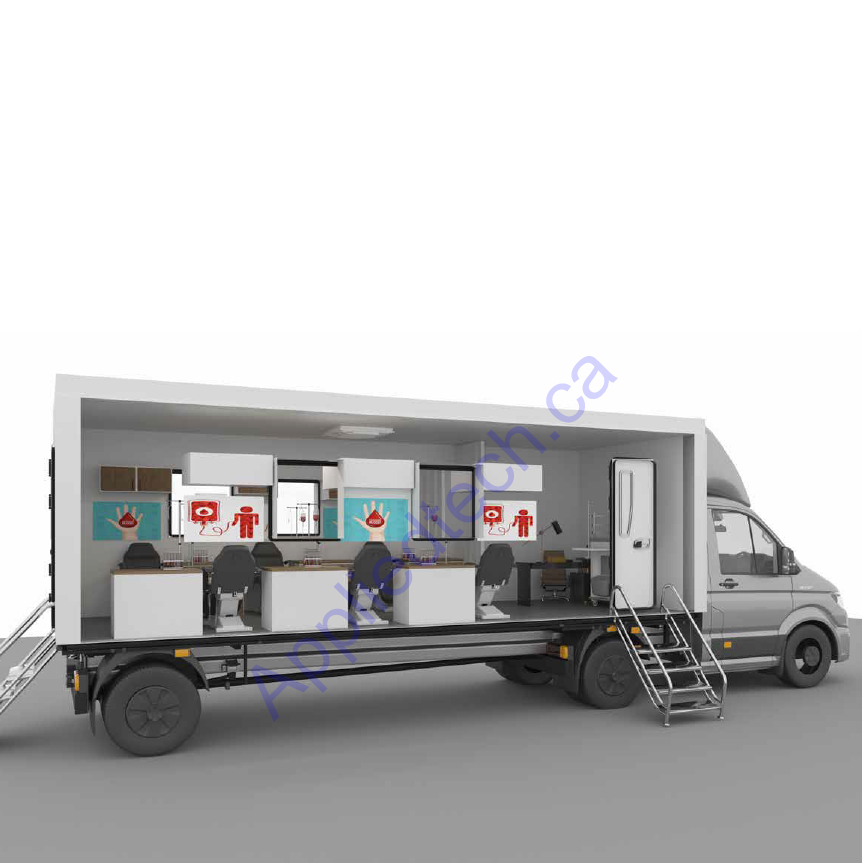1. Vehicle Design
- Engine Power Output: Minimum 180 HP to ensure sufficient power for all operational requirements.
- Fuel: Diesel-powered for long-range mobility and fuel efficiency.
- Emission Level: Euro norm compliant, with a minimum of Euro 4 emission standard. Can be supplied in Euro 4 to Euro 7 levels, depending on requirements.
- Transmission: Minimum 5 forward speeds and 1 reverse gear for ease of operation.
- Traction: 4x2 for enhanced maneuverability and stability.
- Steering: Power steering for improved handling, with options for left-hand drive (LHD) or right-hand drive (RHD), depending on the destination country.
- HVAC: Air conditioning with adjustable air outlets, non-CFC, to ensure a comfortable environment for staff and donors.
- Brakes: ABS brakes or equivalent for improved safety.
- Mirrors: Both left and right-side mirrors.
- Full Lighting and Horn System: Ensures the vehicle is road legal and easily identifiable.
- Wiper/Washer System: Multi-speed with low, high, and intermittent settings for optimal visibility.
- Seating Capacity: Minimum of 2 seats, including the driver, with seat belts for all positions.
- Fuel Tank Capacity: Minimum 200 liters, with a lockable lid for security.
-
Emergency Features: Reversing acoustic warning signal, emergency exits, and hammers for safety.
2. Donor Compartment
- Dimensions: The interior space for the donor compartment is a minimum of 2.30 meters wide, 7.00 meters long, and 2.20 meters high, ensuring ample space for 6 donor beds.
- Doors & Emergency Exits: One main entrance door with a sturdy staircase that can be stowed away during travel. Emergency exits include windows that are easy to break in case of an emergency or optionally, emergency doors on each side of the vehicle.
- Windows: Minimum of 2 frosted, tempered windows on each side of the donor compartment for privacy and natural light.
- Flooring: High-quality, anti-bacterial, anti-static, chemical-resistant, and durable vinyl linoleum that is easy to clean and disinfect.
- Awning: A minimum of 2/3 of the vehicle's length, providing shade for donors and staff during outdoor activities or waiting times.
- Wash Basin: Stainless steel with hot and cold water operated by a foot-activated valve and an electrically driven pump from a separate 180-liter tank.
- Lighting: Ceiling LED lamps, dimmable, with a total output of at least 4800 lumens for sufficient illumination.
- Power Supply: Equipped with external power connection sockets and a heavy-duty industrial cable reel (min. 25m) for easy connection to an external power source.
- Storage: Lockable drawers and shelves made of Formica or equivalent material. Includes a pedal dustbin and lockable cabinets for storing medical supplies.
- Furniture: A desk with a drawer, an office chair with adjustable height and backrest, and an articulated LED desk lamp with a minimum 800 lumens.
-
Medical Equipment Storage: Dedicated space for medical devices, blood collection tools, and refrigeration
units.
3. Medical Equipment
- Blood Donation Reclining Chairs: 6 adjustable chairs designed for donor comfort during the donation process.
- Autoclave: Medical steam sterilizer for sterilizing equipment.
- Blood Bag Tube Sealer: For sealing blood bags
- Blood Bank Refrigerator: A refrigerated unit for the safe storage of blood donations.
- Blood Transport Box: For safe transportation of blood
- Hemoglobin Analyzer: For measuring hemoglobin levels
- Sphygmomanometer: Automatic blood pressure monitor for donor health assessments
- Weighing Scale: For donor weight monitoring
- First Aid Kit: Complete with essentials such as bandages, gloves, antiseptic, and CPR face shields.
-
Blood Collection Monitor: For monitoring donation procedures
4. Auxiliary Features
- Generator: Ensures backup power for all essential systems when external power is unavailable.
- Water Tank: A minimum of 180 liters for the wash basin and other water needs.
- Emergency Window: Easily accessible for emergency evacuation.
- Battery: Backup battery system to maintain power for critical equipment.


